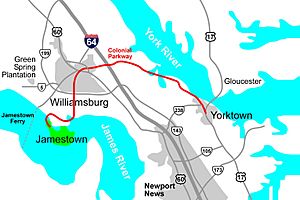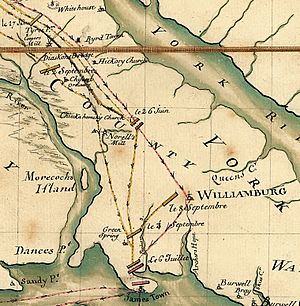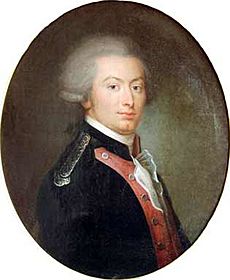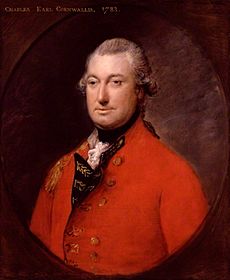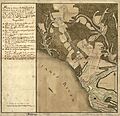Battle of Green Spring facts for kids
Quick facts for kids Battle of Green Spring |
|||||||
|---|---|---|---|---|---|---|---|
| Part of the American Revolutionary War | |||||||
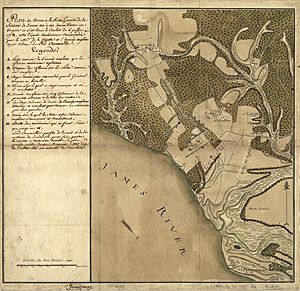 A French map depicting the battle |
|||||||
|
|||||||
| Belligerents | |||||||
| Commanders and leaders | |||||||
| Strength | |||||||
| 800-900 | about 7,000 | ||||||
| Casualties and losses | |||||||
| 28 killed 122 wounded |
75 killed and wounded | ||||||
The Battle of Green Spring was a fight during the American Revolutionary War. It happened on July 6, 1781, near Green Spring Plantation in James City County, Virginia. American General Anthony Wayne, known as "Mad" Anthony, led a part of the army of the Marquis de Lafayette. They were ambushed by the British army led by Earl Charles Cornwallis. This was one of the last big land battles in Virginia before the important Siege of Yorktown.
For a month, Cornwallis and Lafayette had been marching around central Virginia. In late June, Cornwallis moved to Williamsburg. He then received orders to go to Portsmouth and send some of his soldiers to New York City. Lafayette followed Cornwallis closely. He felt stronger because more American soldiers had arrived. He thought about attacking the British.
On July 4, Cornwallis left Williamsburg for Jamestown. He planned to cross the James River to get to Portsmouth. Lafayette believed he could attack Cornwallis's rear guard while they were crossing the river. However, Cornwallis expected Lafayette's plan. He set up a clever trap. General Wayne's soldiers almost fell completely into it. Only a brave bayonet charge against the much larger British force allowed Wayne's men to escape. Cornwallis did not chase them after his victory. Instead, he continued his plan to cross the river. This battle made people continue to call Wayne "Mad" because of his daring actions.
Contents
Why the Battle Happened
In May 1781, Earl Charles Cornwallis arrived in Petersburg, Virginia. He had marched through North and South Carolina. He took command of 1,400 of his own men and 3,600 more soldiers. These additional troops had been under the command of Benedict Arnold, who had switched sides to the British. Soon, Cornwallis got about 2,000 more soldiers from New York.
The American forces were much smaller. They were led by the Marquis de Lafayette, who was in Richmond. Cornwallis wanted to stop Virginia from helping the American Revolution. He chased Lafayette's army, which had only about 3,000 men. Many of Lafayette's soldiers were inexperienced militia.
Lafayette managed to avoid fighting Cornwallis directly. Cornwallis used his larger army to send groups to raid American targets. These targets included military supplies and important political places. After about a month, Cornwallis turned back east toward Williamsburg. Lafayette's army grew to about 4,000 men. He received more Continental Army soldiers under General Anthony Wayne. He also got more experienced militia under William Campbell.
With more troops, Lafayette became more aggressive. He sent out groups of his soldiers to fight Cornwallis's raiding parties. One of these fights happened at Spencer's Ordinary in late June.
When Cornwallis reached Williamsburg, he got new orders. General Sir Henry Clinton told him to go to Portsmouth. He also had to prepare some troops to return to New York City. So, Cornwallis started moving south on the Virginia Peninsula on July 4. He planned to cross the wide James River at the Jamestown ferry. Lafayette followed him. His lead units and most of his main army reached Norrell's Mill, about 8 miles (13 km) from the ferry, on July 5.
Lafayette saw a chance to attack the British while they were crossing the James River. This was a difficult move for a large army. Cornwallis also saw this possibility. He decided to set a trap. He hoped to capture a part of Lafayette's army. Cornwallis only sent his baggage train and John Graves Simcoe's Queen's Rangers across the river. He hid his main army near the crossing point. Cornwallis also sent some men to pretend to desert to the Americans. These "deserters" told the Americans that most of the British army had already crossed. They said only a small rear guard was left on the north side of the river.
Setting the Trap
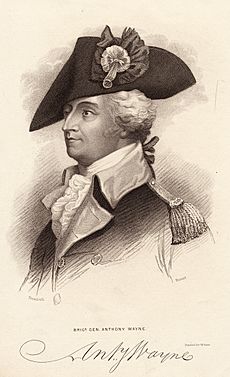
Cornwallis chose a very good place to hide his army. On the left, there was a swampy area that went down to the river. It was impossible to cross. On the right, there was more marshy ground and some ponds. The only way to reach the ferry from the mainland was a 400-yard (366 m) causeway from the Green Spring Plantation. This causeway was surrounded by marshlands. An attacking army would have to go through these difficult areas.
Cornwallis set up his army in two lines. On the left were the 76th and 80th regiments, part of the 43rd, and Banastre Tarleton's British Legion. On the right were the Brigade of Guards and Hessian soldiers. Both sides also had light infantry companies. Cornwallis left a small group of German jägers and a few men from the Legion. They were meant to look like a small rear guard. He told them to fight the American advance as much as possible.
General "Mad" Anthony Wayne led Lafayette's advance group. This group had about 500 men. They left Norrell's Tavern early on July 6. When Wayne reached Green Spring, he looked at the land. He saw the British guards. When Lafayette arrived with his main force, they decided to attack. Lafayette ordered more troops to come forward from Norrell's Tavern around 1 p.m. There were some small fights while they waited for these troops.
Wayne's 500 soldiers included 200 Virginia riflemen. They were led by Majors John Willis and Richard Call. Other light infantry groups were led by John Francis Mercer, William Galvan, and McPherson. Colonel Walter Stewart's Pennsylvania Continental battalion was held in reserve. Lafayette sent forward two more Pennsylvania Continental battalions. These were led by Colonels Richard Butler and Richard Humpton. He also sent Major John P. Wyllys' light infantry battalion.
Lafayette started to suspect something was wrong. He held back two light infantry battalions. These were led by Colonels Francis Barber and Joseph Vose. The three battalions that reinforced Wayne increased his force to between 800 and 900 men. Wayne's force now had two companies of riflemen, one of dragoons, and most of the Pennsylvania Line. They also had three field artillery cannons. As they moved out, Lafayette rode to a spot on the riverbank. From there, he could watch the battle.
The Battle Begins
Wayne's advance force and the British guards started a long fight. It lasted almost two hours. The British soldiers slowly pulled back. They lost many men as the Americans kept pushing forward. Wayne's riflemen were very good. They shot several British officers.
However, the situation changed around 5 p.m. The Americans reached a cannon that Cornwallis had left in the road. It seemed abandoned. When the Americans took the cannon, it was a signal for the British to counterattack. The British started by firing canister and grape shot from their cannons. Then, their infantry soldiers charged forward.
Lafayette was watching from the river. He saw the main British army and realized Wayne was walking into a trap. But he could not reach Wayne in time to call him back. He immediately started moving more American troops forward. He wanted to stop the trap from closing on Wayne.
Meanwhile, the British charge had confused the Americans. Wayne was worried that a retreat would turn into a messy escape. Wayne quickly reorganized his soldiers. He ordered his cannons to fire grape shot. Then, he had his soldiers charge the much larger British force with bayonets.
Wayne's brave charge worked. It stopped the British advance long enough for Lafayette's helping force to arrive. Lafayette rode forward to help manage the American retreat. The retreat started to fall apart after Cornwallis personally led a countercharge. During the retreat, two American cannons had to be left behind because their horses were shot. Lafayette also lost his horse. As the sun began to set, Cornwallis decided not to chase the Americans. They retreated to Green Spring.
What Happened Next
British reports said they had 5 officers and 70 soldiers killed or wounded. American reports said about 140 Americans were hurt, including 28 killed. Cornwallis was happy with his victory. He did not chase the Americans. Instead, he crossed the James River as planned and moved to Portsmouth.
At Portsmouth, his plans to send troops away were changed. New orders from Clinton told him to build a strong naval base instead. Cornwallis chose to do this at Yorktown. There, he was forced to surrender after a short siege in October 1781.
Lafayette, in his reports, described Cornwallis's moves to Williamsburg and Portsmouth as a retreat. These reports made Lafayette's reputation even better. Even though the battle was a loss, it did not harm his image. General Wayne wrote that his decision to charge the British was "one of those prudent, tho' daring manoeuvers which seldom fail of producing the desired effect." Lafayette publicly praised Wayne. But in private, he wrote that Wayne made mistakes. He said the battle looked good "in a gazette" (newspaper).
The Battlefield Today
Parts of the Green Spring Plantation were bought in 1966 by the National Park Service. They are now part of the Colonial National Historical Park. These areas were added to the National Register of Historic Places in 1978. As of June 2010, you can visit them only by special arrangement.
Images for kids


